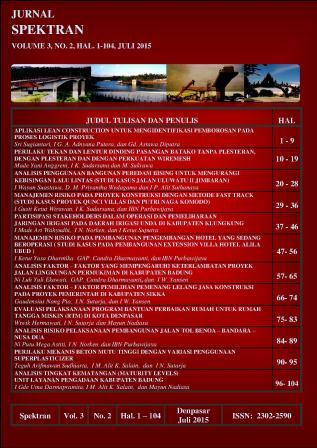PERILAKU MEKANIS BETON MUTU TINGGI DENGAN VARIASI PENGGUNAAN SUPERPLASTICIZER
Abstract
Concrete itself is quite popular in terms of usage in the field of construction (bridges, buildings, and dams). In large projects and unconditioned special (extreme) as the long-span bridge construction in the middle of the sea, pier construction, buildings and retaining walls high sea waves need to use high-quality concrete. To be able to make high strength concrete required fas value (water-cement ratio) is low, ranging from 0.20 to 0.30 (ACI, 1998). In high quality concrete workmanship in the field, to facilitate construction of concrete because considering using a little water, then a superplasticizer admixture materials needed to facilitate mixing concrete.
This study was conducted to determine the performance of each in terms of value Slump superplasticizer, concrete compressive strength and split tensile strength of concrete. Calculation of SNI 03-6468-2000 material refers to the weight ratio of cement: fine aggregate: coarse aggregate of 1.00: 1.67: 2.15 with water cement factor of 0.317. Used to test a cylindrical specimen with a diameter of 150mm and height of 300mm which for the life of the test was made three (3) pieces of the specimen. Preparation and treatment of test specimens performed by standard procedures.
The results showed that the use of superplasticizer type Napthalene Formaldehyde Sulphonate deliver results better compressive strength than the type superplasticizer Aqueous Solution Of Modified Polycarboxylate Copolymers is equal to 7.70%, but when viewed in terms of tensile strength and slump value (kelecakan) type superplasticizer Aqueous Solution Of Modified Polycarboxylate Copolymers provide better value Napthalene Formaldehyde Sulphonate when compared with that of 4.04% for split tensile strength and 22.22% for the slump value.



